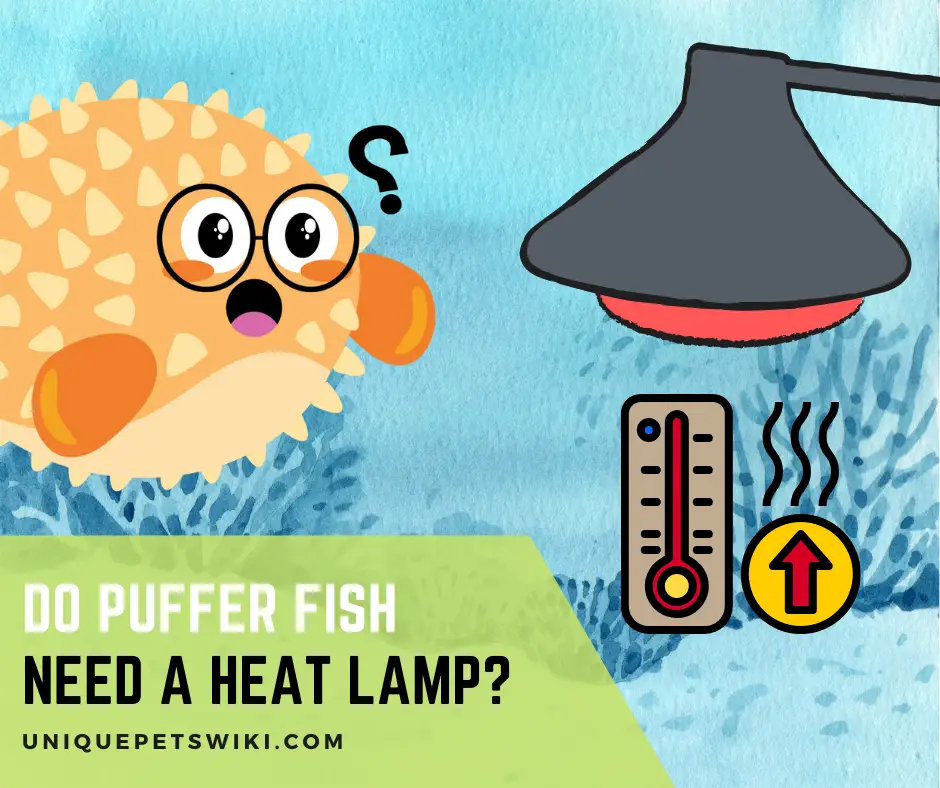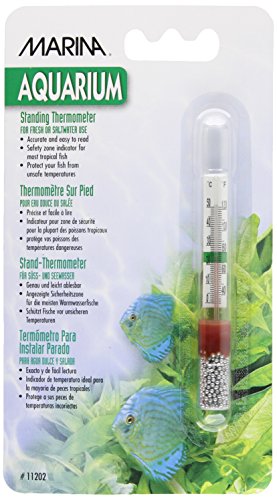One of the most common questions puffer fish owners have is “do puffer fish need a heat lamp?“
If you have researched pufferfish, then you already know that they are tropical creatures that live in warm water. They also need very specific water conditions for survival. Therefore, it is important that every pufferfish considers the question of whether their pet needs a heat lamp.
In this guide, we will cover this topic in detail and tell you exactly when a puffer fish needs a heat lamp.
Contents
Do Puffer Fish Need a Heat Lamp?
The answer to the question, do puffer fish need a heat lamp, is not straightforward. Sometimes, under certain circumstances, puffer fish might need a heat lamp but, under other circumstances, they can do without one.
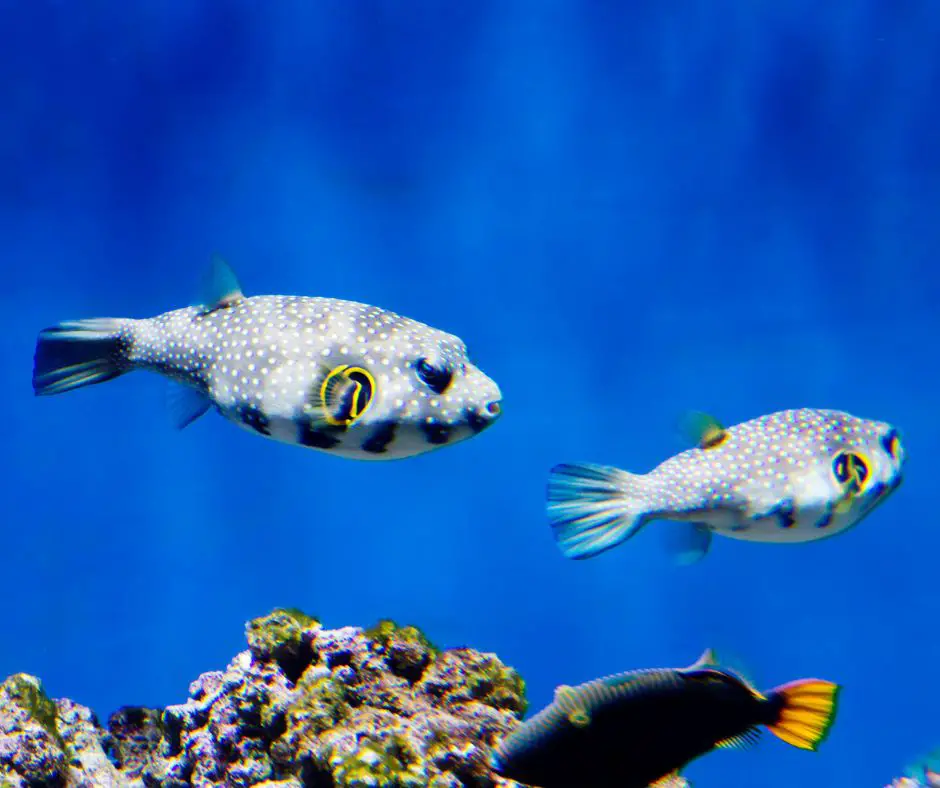
Pufferfish are tropical creatures. They live in warm, sunlit zones where the water temperature is over 70 F.
You see, pufferfish aren’t equipped to handle cold temperatures below 65 F. They could catch diseases or experience stress which can impact their health negatively. In the worst-case scenario, your pet might even die if exposed to such low temperatures for prolonged periods.
If the location where you live has temperatures dropping below 70 F, you might want to use a heat lamp or a heater for warming up your puffer’s water. Also, if you have air conditioning or if the water temperature fluctuates (drops at night time), then too a heat lamp is essential for your pet’s survival.
A word of caution here: heat lamps produce bright light and glare that could hurt your puffer fish. Pufferfish are better off with a water heater instead of a heat lamp. Heat lamps are more suitable for reptile enclosures.
Ideal Light Setup for Puffer Fish Tank
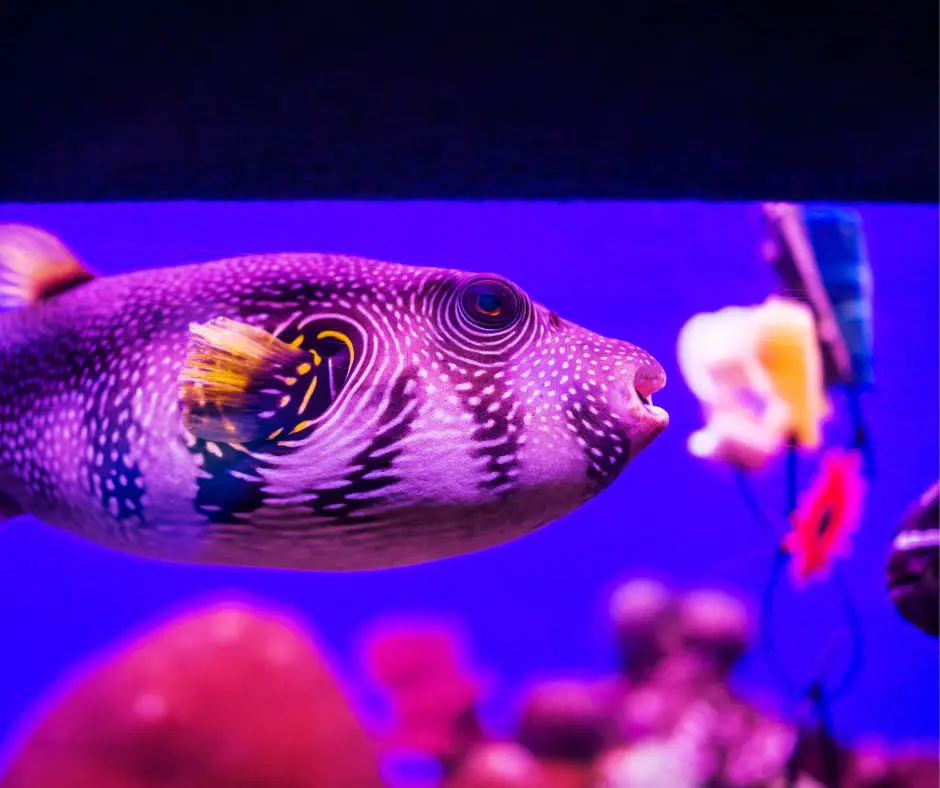
Like all living beings, pufferfish follow a circadian rhythm so the best light set up for the pufferfish tank should also follow that circadian rhythm.
If your fish tank is kept outdoors, then you do not need any special lighting.
For indoor tanks, the lowest stress environment for your puffer fish is one that mimics the natural light cycle. You may also want to incorporate seasonal changes. If you cannot follow seasonal changes, then simply provide a standard period of light and dark.
The lighting requirements of your puffer’s tank also depend upon the plants you have in it. Some plants have high PAR requirements. PAR stands for Photosynthetically Active Radiation. It is the light responsible for the growth of plants and beneficial algae.
Most planted aquariums do well with a light of 6500 to 7500 Kelvin. Marine reef tanks for marine puffer fish need 300-500+ PAR.
The wrong light can be detrimental to your puffer’s health while the right light can help it thrive. Here are the benefits of using proper light for puffer fish tanks:
Importance of Light for Pufferfish Tank
- Light provides energy to your pet.
- If you have a planted aquarium, then the plants need light for photosynthesis.
- Light is also essential for the healthy growth of young puffer fish. Moreover, it is necessary for the growth of useful bacteria, corals, plants, and other tankmates.
- Without light, the oxygen levels, and the water chemistry in the tank can be adversely impacted.
- Furthermore, good aquarium lighting enables you to see your tank clearly at night and enhances the viewing pleasure.
The Best Option to Setup Light for Puffer Fish Tank
Earlier, fish hobbyists had no option but to use bulky halogen lamps for their aquariums. Gone are those days! Today, you have a wide variety of lighting options for your fish tanks:
- LED lights – LEDs are slim, inexpensive to operate, and available in a variety of color choices. You also have a wide choice of LED lights in sizes, operating temperatures, and costs. The best part about the LED light setup for pufferfish tanks is they generate consistent color of light throughout their lifetime.
- Fluorescent lights– These are also available in a variety of sizes but are best suited for planted freshwater aquariums. The downside is that Fluorescent lights tend to shift the color spectrum from white to yellow over a period of 3-6 months and aren’t consistent as LED lights.
Ideal Temperature for Puffer Fish Tank
The optimum temperature range for pufferfish tanks is between 74F and 80 F. Most pet store fish tanks for pufferfish are kept at 74 F and some pufferfish enthusiasts recommend keeping the temperature between 78 and 81F.
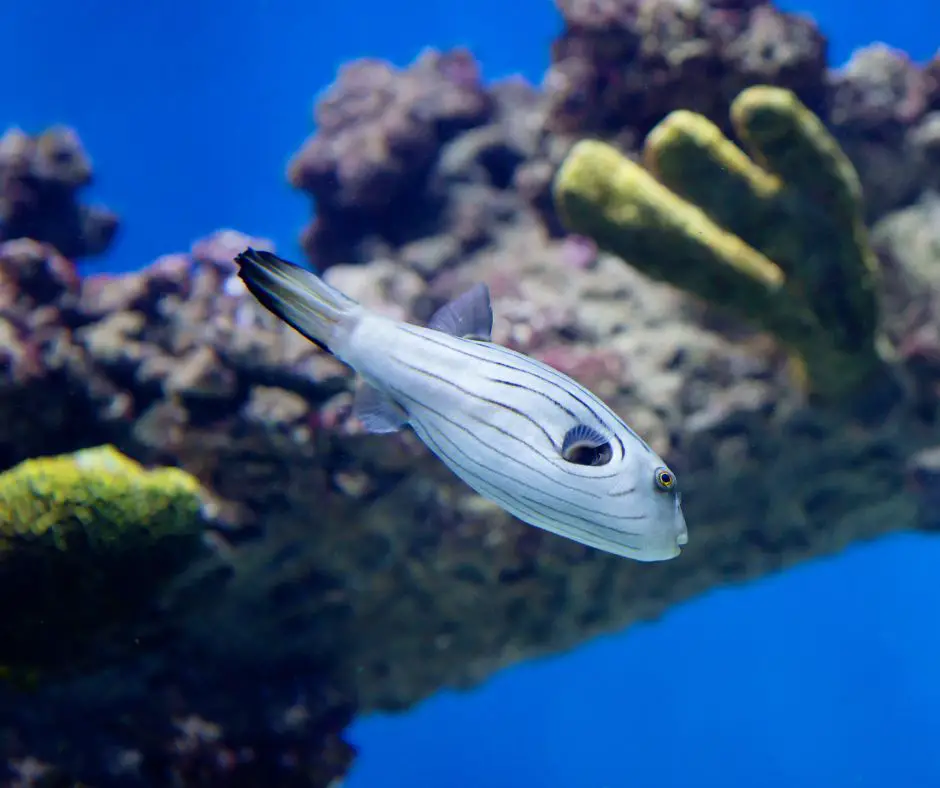
Importance of Right Temperature for Pufferfish
- One thing is clear: pufferfish are tropical fish and they need warm water, prolonged exposure to water temperatures below 65 F could harm your pufferfish. It could develop stress which could translate into diseases.
- Very high temperatures over 85 F tend to make pufferfish overactive and that too can stress them out. Temperatures over 90F could kill your fish.
What is the Best Option to Control and Monitor your Pufferfish Tank Temperature?
As can be seen, maintaining the optimum temperature range is vital for your puffer’s health. Here are some steps and equipment to use to control and monitor your pufferfish tank temperature:
Use a thermometer – Hang-on thermometers help you easily monitor your aquarium’s water temperature. Check the reading every time you look at your tank and ensure there are no unusual changes.
Marina Standing Thermometer, Fahrenheit and Celsius Aquarium Thermometer
- Fish tank thermometer designed to sink to the bottom
- Remains standing in a vertical position
- Accurate and easy-to-read thermometer
- Provides readings in Fahrenheit and Celsius
- Includes safety zone indicator appropriate for most tropical fish
Last update on 2022-12-29 / Affiliate links / Images from Amazon Product Advertising API
Use a water heater – If temperatures fall below 70F in the area you live in, or it is winter or if you have air conditioning in your fish tank room, then use an aquarium heater. Many heaters come with thermometers as well so you know your fish are in optimal conditions.
Be sure to use a heater that is appropriate for the tank size. Place the heater in the center of the tank to keep the temperature stable throughout. The best aquarium heaters are ones that can be programmed to maintain the temperature range suitable for your species of fish.
Fluval E200 Advanced Electronic Heater, 100-Watt Heater for Aquariums up to 65 Gal
- Aquarium heater with dual temperature sensors provide accurate and real-time water temperatures
- LCD temperature display available in both Fahrenheit and Celsius; with a range of 68 to 93 degrees Fahrenheit
- Fast heat technology built with a safety shut-off and integrated fish guard to protect fish and invertebrates
- Equipped with a slim profile mounting bracket and colored display alert system
- 200-watt heater for freshwater and saltwater aquariums up to 65 gallons with a 5-year warranty
Last update on 2022-12-29 / Affiliate links / Images from Amazon Product Advertising API
Keep the water levels constant – Water is always evaporating from your fish tank, even if it has a lid. As water levels change, the temperatures fluctuate. So, keep the level constant. If you are making water changes, that too can cause temperature fluctuations. So, use properly balanced, conditioned water regularly and do not lets the levels drop too much.
Puffer Fish Tank Setup
The best tank setup for puffer fish takes into account the substrate, plants, temperature, and other water parameters. Here are some general guidelines:
- Tank size – Choose an appropriately sized tank for your puffer. Most puffers need a lot of room as they are very territorial. A smaller pea puffer can be housed alone in a 10-gallon tank and 2-3 pea puffers will need at least a 20-gallon tank.
- Water parameters – Maintain the temperature between 74 and 80 F. Ammonia and nitrite levels should not be more than 0 ppm and nitrate should be less than 20 ppm. GH and KH (the measures of hardness) and salinity levels will be different for different pufferfish species, so research your species properly.
- Substrate – Fine or coarse sand, gravel, and/or crushed coral are good choices depending on your species.
Glofish Aquarium Gravel, Black with White Fluorescent, 5-Pound Bag
- AQUARIUM GRAVEL: GloFish Aquarium Gravel creates a colorful base for all your GloFish ornaments
- RANGE OF COLORS: Choose from a variety of colors to best complement your aquarium décor
- BASK IN THE GLOW: Fluorescent-accented gravel stands out under GloFish blue LED lights
- HIGHLIGHTS YOUR TANK: Use as a substrate or accent, along with GloFish plants and ornaments (sold separately)
- EXPERIENCE THE GLO GloFish fluorescent fish and products create a complete underwater fluorescent experience
Last update on 2022-12-29 / Affiliate links / Images from Amazon Product Advertising API
- Plants – pufferfish need plants and without live plants, they tend to get stressed. Choose hardy and fast-growing plants like Anubias, Java moss, and Java ferns.
- Tank mates – It may be best to house pufferfish alone as they tend to be territorial and aggressive. You may house two pufferfish of the same species together but do observe for fights and separate your pets if you see signs of aggression. Other suitable tankmates are species of submissive fish who will stay away from the puffer. Some options are Danios, mollies, scats, and gobies.
FAQs
Do puffer fish need a heater?
Pufferfish would require a heater if the water temperatures tend to fluctuate or drops below 70F. They certainly need a heater if you live in a very cold area or if you have central air conditioning.
What does a pufferfish need to live?
A puffer fish needs a spacious tank with proper water conditions, live plants, and hard-shelled foods like crabs, mollusks, shrimp, starfish, and urchins to live.
Is it hard to care for puffer fish?
Puffers need very stringent water conditions and are not the best choice as pets for novice fish keepers. Once you learn how to care for them and can easily maintain the right water conditions then keeping a puffer fish can be very rewarding.
Can puffer fish live in cold water?
While pufferfish can live in cold water, prolonged exposure to temperatures below 65F could stress the fish and impact its health adversely. Over time, your pet might even die.
Wrapping Up – Do Puffer Fish Need a Heat Lamp?
Pufferfish may or may not need a heat lamp; it depends on the water temperature and how stable you can maintain it between 74 and 80 F.
As such, a heat lamp is very bright and its glare could hurt your pet’s eyes. An aquarium water heater may be a better choice whereas a heat lamp might be better off for a reptile enclosure.
